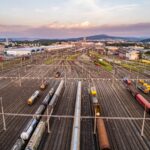The publicly published information on the freight train derailment in the Gotthard Base Tunnel indicates a broken wheel on the derailed train. Overloading or material defects are under consideration as possible causes of the failure. What actually happened remains a matter for the ongoing investigations of the Swiss Transportation Safety Investigation Board (Sust).
Topics discussed:
- How are safety-critical components manufactured?
- How are they approved and put into operation?
- How are they maintained?
- What significance does monitoring have in daily operations?
- Which monitoring possibilities exist?
- Uniform rules enable safe cooperation between the actors
- Outlook for digital automatic coupling (DAC)
How are safety-critical components manufactured?
Safety-relevant and safety-critical components such as wheel pans are designed so as to perform their task over the planned period of use under the prevailing conditions of operation and use and thereby to ensure safe travel. The manufacturing firms make use of internationally recognised standards to accomplish this:
- Technical Specifications for Interoperability (TSI) establish fundamental requirements.
- European Standards (EN) define the specific properties.
- Manufacturers employ harmonised and standardised safety methods for development and testing.
- Standardised safety verifications and assessments document the safety and usability.
The international experiences from incidents and accidents continuously enter into the development of the standards and TSI.
How are they approved and put into operation?
Bringing safety-critical components onto the market requires an internationally standardised approval from the European Agency for Railways (ERA) or a national safety authority. This consists of:
- Type approvals for components or vehicles
- Conformity verifications for identical serial parts or vehicles
- CE mark (Conformité Européenne) for a component that satisfies the applicable EU directives
- Operating authorisation for a vehicle in compliance with the rules
The certification that components were manufactured according to the requirements of standards and TSI is issued by so-called “notified bodies”, in other words state-authorised agencies. These inspect and evaluate whether the manufactured products conform to the rules.
How are they maintained?
The manufacturer is obliged to define and publish the applicable maintenance requirements for all components or vehicles. Wagon keepers must implement these manufacturer requirements in accordance with the conditions of use. They appoint certified entities in charge of maintenance (ECMs) for their rolling stock. The latter in turn establish maintenance requirements for the vehicles assigned to them in consideration of their own knowledge and industry expertise. They also plan regular work, carry it out and document the results. Every wagon approved for operation must be registered in an official vehicle registry, including the name of the wagon keeper and the ECM.
What significance does monitoring have in daily operations?
The railway undertakings (RUs) are responsible for the safe travel, preparation, dispatching and other safety aspects of their trains. They define the inspections and tests for ensuring that every trip can be completed safely. To determine this operational suitability, trained employees carry out defined visual inspections before departure. This extremely demanding work takes place at all times of day and in all weather. During the train dispatching and the associated inspections and tests, safety-critical components are also afforded special attention.
Which monitoring possibilities exist?
The wagon keepers are responsible for the proper maintenance of their vehicles. Safety-relevant and safety-critical components are regularly inspected, such as with ultrasound measurements. Safety-critical components are subject not only to strict inspections but also special obligations with regard to labelling, maintenance and traceability of the measures. The RUs can demand wagon-specific information from the wagon keepers.
On the Swiss standard gauge network, the infrastructure operators currently maintain over 250 wayside train monitoring systems. These monitor every vehicle as it passes by for irregularities and can trigger alarms in the event of unacceptable deviations. In this case, the respective train is immediately stopped and inspected.
Uniform rules enable safe cooperation between the actors
A variety of different companies all work together in railway operations. Every actor must be able to depend on the reliability of the others at the points where they interface together. Their tasks and responsibilities are clearly and uniformly regulated at the international level. Harmonised regulations for manufacture, operation and maintenance ensure safe rail transport (for more on the regulations governing the international cooperation, check back on this blog again soon).
Outlook for digital automatic coupling (DAC)
Besides implementation of the applicable requirements by every actor participating in rail transport, new technologies are now coming to the fore. Automation and digitalisation can do more than simply make operating processes more efficient. They also open up new opportunities for operational monitoring of safety-relevant and safety-critical components in freight trains. The ongoing digital recording of the condition of these components offers an attractive opportunity to the responsible parties. By digitally tracking processes of wear and ageing processes on each individual vehicle, it is possible to efficiently plan maintenance work according to the actual needs. Faulty components can be identified and replaced before a total failure. If a component failure occurs during travel, this can immediately trigger an alarm.
To make use of this innovation in freight transport, the wagons require sensor systems, electrical energy and data communication with the train driver, the systems of the wagon keepers and the ECMs. These prerequisites will be met with the planned Europe-wide introduction of DAC (see the blog post “Data ecosystems: Sharing data to double its added value”). In this way, automation and digitalisation are transforming conventional rail freight operations into an intelligent, efficient, resilient and safe mode of transport.



